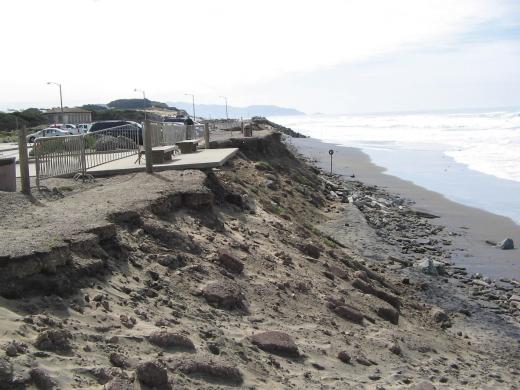Recent data from the National Oceanic and Atmospheric Administration (NOAA) suggest that an El Niño phenomenon may develop in the Pacific Ocean this year. El Niño weather patterns — or properly El Niño Southern Oscillations — typically generate wetter and more frequent winter storms in California, with potential implications for erosion at Ocean Beach. What will these storms mean for the future of the beach, and for the recommendations in SPUR’s Ocean Beach Master Plan?
The El Niño pattern generally occurs every two to five years when surface temperatures rise in the central Pacific, driven by a reversal in the usually easterly trade winds. This results in greater precipitation in California — sometimes much greater, as in the winter of 1996-97, which saw more than 47 inches of rain in San Francisco and considerable erosion at Ocean Beach.
Since this spring, scientists have been warning that an El Niño — potentially a major one — looked likely. NOAA’s Climate Prediction Center has issued an “El Niño Watch.” From the standpoint of California’s record drought, many at first saw this as a ray of hope. But more recent estimates suggest a more modest El Niño, which may not be sufficient to increase rainfall in Northern California by much — but may still cause coastal erosion. Current estimates put the chances of an El Niño developing this winter at about 80 percent.
 Erosion at Ocean Beach resulting from the 2009-2010 El Niño storm season. Photo courtesy the San Francisco Department of Public Works.
Erosion at Ocean Beach resulting from the 2009-2010 El Niño storm season. Photo courtesy the San Francisco Department of Public Works.
It’s been more than four years since a devastating series of winter storms caused severe erosion at the south end of Ocean Beach, in the winter of 2009-10. In some locations, bluffs receded 40 feet in a single season, threatening the Great Highway, coastal parking lots and underground sewer infrastructure. San Francisco responded by placing boulder revetments (embankments of stone riprap) on the beach, creating controversy among environmentalists, surfers and the California Coastal Commission. It wasn't the first time. The same pattern — an El Niño storm season, severe erosion and emergency coastal armoring — occurred in 1997.
Boulder revetments at Ocean Beach. Photo courtesy the California Coastal Records Project.
In 2011, the Coastal Commission rejected a city permit application for both existing and additional armoring, demanding instead a long-term plan to address coastal hazards. SPUR was already at work on the Ocean Beach Master Plan, which took on a new urgency. Meanwhile, the city turned to softer, more adaptive measures, including the placement of sandbags and “backpassing” of large quantities of excess sand from the north end of Ocean Beach to the eroded sections at the south end.
The Ocean Beach Master Plan recommends closure of the Great Highway south of Sloat Boulevard for “managed retreat” (i.e., gradually removing manmade structures in the path of sea level rise) in the coming decades. The San Francisco Department of Public Works is planning to narrow the road to two lanes within a few years, and aggressive measures to prevent erosion are no longer the order of the day. SPUR and its consultants are working with the San Francisco Public Utilities Commission (SFPUC) and the Coastal Commission on a package of softer measures, including additional sand placement, sand bags and the consolidation of existing rubble into a smaller, erosion-resistant footprint. These steps are intended to get the beach through several storm seasons without the need for additional structures like revetments or sea walls, while longer-term measures are developed to implement the master plan vision.
Will the softer measures be adequate if an El Niño season produces a series of powerful storms? It’s difficult to say with certainty, but there are several reasons to be optimistic.
First, the responsible agencies are focused on protecting critical wastewater infrastructure, rather than the roadway or parking lots, meaning there is a greater tolerance for letting nature take its course.
Second, the existing revetments, though controversial, are in place and effectively protecting what had been the most vulnerable areas. In addition, the sandbags that were placed in 2011 have held up very well, providing coastal protection that is easily reversible, inoffensive and easily expanded.
Lastly, the city is in a much more proactive stance, proposing measures in advance of anticipated storms and preparing to act quickly if threats develop. In particular, the SFPUC is preparing to implement additional preventive sand placement and to fill and stockpile sandbags in advance of winter storms, for rapid deployment.
There are, of course, no guarantees. If this year’s El Niño produces severe and repeated storm surges, the environmental risk of a ruptured sewer could reach an unacceptable level, requiring emergency armoring. But for the first time, all actors are working together to make armoring the action of last resort and to prepare a more adaptive approach.
